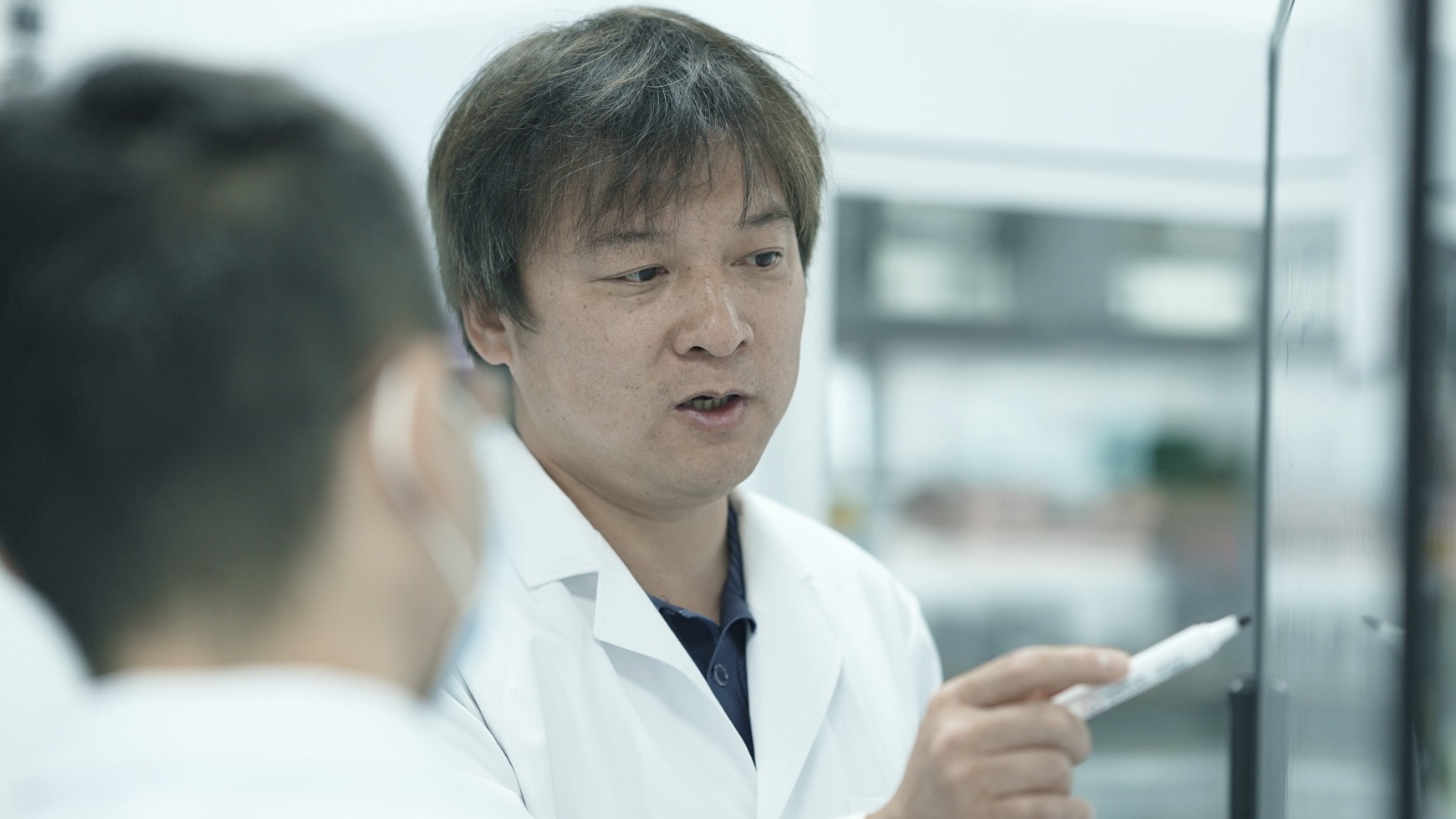Repairing and regenerating injuries in the brain – the most complex organ in the human body – remains a challenge despite advances in medical science. BGI-Research and a team from the Guangdong Provincial People's Hospital led by Professor Fei Jifeng, a pioneer in the field of salamander regeneration research in China, are working together to better understand the regeneration mechanism of the brain and organs.
 Professor Fei Jifeng
Professor Fei Jifeng
In September, BGI-Research and Professor Fei, along with other international researchers, used BGI’s revolutionary STOmics technology to construct the world’s first spatiotemporal cellular atlas of axolotl brain development and regeneration, revealing how a brain injury can heal itself. The study was published as part of the cover feature in Science.
In an interview, Professor Fei shares why he chose this research field, what is involved in realizing the goal of human organ regeneration through the collaborations with BGI-Research, and the role that spatiotemporal omics technology plays in advancing this research.
Q: You have been conducting research in the development and regeneration of the human central nervous system for many years. Why have you chosen this field?
A: First of all, the regeneration of the central nervous system is simply a super exciting and interesting topic. During my Ph.D. in Germany, I used mice as a model to study mammalian brain development. In the post-doctoral stage, my research topic was the regeneration of the salamander spinal cord. My post-doctoral advisor, Professor Elly Tanaka, is one of the leading scientists in the field of regeneration research in the world. Her main research direction is to use salamanders as model organisms to study the regeneration of tissues and organs. After returning to China, following my doctoral research direction, I expanded my research scope and began to study the regeneration of the central nervous system, with particular focus on the brain.
Of course, tissue and organ regeneration is also one of the most important scientific issues that have not yet been resolved. The international journal Science once listed organ regeneration as one of the 125 most cutting-edge scientific issues in the world on its 125th anniversary. In recent years, more and more researchers have begun to pay attention to this field, but at present, our understanding of regeneration is still very limited.
Q: What is required to realize the vision of human organ regeneration? Where are we at the current stage of research?
A: Whether the human brain and other organs can regenerate after pathological and physical damage is a relatively complex issue that needs to be studied from multiple perspectives. There are also many different attempts to study this both in China and abroad.
We start with the model animal salamander, which has a strong regeneration ability, and hope to translate the phenomenon of salamander regeneration to higher mammals, and eventually to humans. Of course, it is expected this will be a very long-term process, but I firmly believe that this goal is achievable. Taking the research results we published in September as an example, it is currently in the category of basic research, and a deeper development focuses on how to apply this mechanism to mammals. This is a process from basic research to applied research, and there is still a lot of work to be carried out.
Q: What are the main challenges in translating the regeneration mechanism of salamanders to mammals? How can these challenges be resolved?
A: The salamander regeneration phenomenon itself needs to be studied at multiple levels, and there are many difficulties involved. For example, what is the key factor for salamanders to activate this powerful regeneration ability? What are the cellular and molecular differences behind mammalian and salamander regeneration? What are the factors limiting mammalian regeneration? We still have to understand and solve these problems from a technical point of view.
Next, we and BGI-Research will also conduct comparative biological research based on salamander regeneration, but not limited to salamanders, using BGI's spatiotemporal omics technology and single-cell technology. That is, use salamanders to study the process of regeneration, and use mice or other non-regenerative model organisms to study the process of limiting regeneration, and compare these two. It can also be carried out in combination with biological materials and 3D printing technology in cross-species research. These are all efforts to gain a deeper understanding of regeneration and provide some clues for the realization of damage repair in mammals, and even humans.
Q: In May this year, an international scientific organization, the SpatioTemporal Omics Consortium (STOC), was established. You are also a core member of the consortium. In your opinion, what role does spatiotemporal omics technology play in research work?
A: The original intention of the STOC is to use spatiotemporal omics technology to promote the development of scientific research in various fields. In fact, spatiotemporal omics technology played a very important role in this study, making up for the shortcomings of single-cell technology, which cannot obtain the original spatial location information of each cell. Based on spatiotemporal omics technology, we can track the spatial location of a small number of cell types and changes in cell activity, which are important for the study of injury-induced regeneration and many other developmental processes.
Taking injury-induced regeneration as an example, we know that this is a complex process, and the two phases of damage and regeneration are highly coupled. The spatiotemporal omics technology allows us to study how these complex and rapidly changing physiological processes gradually unfold in a local environment, such as near the injury site. We hope that through this technology, we can dissect all the links in the entire injury regeneration process to gain a deeper understanding of mammals and salamanders, which represent the differences between non-regenerative model organisms and regenerative model organisms at every level.
Q: What opportunities exist for your team to carry out research collaborations with BGI-Research?
A: I think the most basic thing in common is interest. In fact, after returning to China, I have been looking for a suitable partner, and BGI-Research has also independently carried out research on salamander limb regeneration before. It can be said that everyone came together based on a common interest in the scientific issue of regeneration. In 2019, both sides met for the first time and talked about topics of interest. The willingness to cooperate was very strong, and we gradually got in contact to cooperate.
BGI-Research's strengths lie in multi-omics technology and bioinformatics analysis. Our laboratory is good at refining important scientific issues in the field of regeneration, building animal models, collecting and analyzing samples, and experimental verification. The two teams complement each other's strengths. Of course, there are some difficulties in the progress of the project, so sometimes BGI-Research’s research team will come to my laboratory to carry out some experimental work. During discussions, we also extended our cooperation into many other projects.
Q: During the process of collaboration with BGI-Research’s research team, were you impressed with anything in particular?
A: My first impression is that BGI-Research’s researchers are very enthusiastic about scientific research. Later, through cooperation, I found that the work efficiency of the BGI-Research team is also very high, not only for the whole project, but also for even small issues. When I was conducting scientific research abroad previously, a scientific research project generally took about four years from beginning to end, but BGI-Research's projects usually take about two years, which is very efficient. Such improvement in efficiency is directly related to the model of project development, which is something worthy for me to learn.
Q: Apart from the results published in September, how are the research collaborations between Guangdong Provincial People's Hospital and BGI-Research progressing?
A: At present, our laboratory and BGI-Research have a number of important collaborative research directions. We hope to use spatiotemporal omics technology, combined with single-cell sequencing and multi-omics technology, to further analyze the regeneration mechanism.
We know that during brain regeneration in salamanders, cells undergo a fate-reversal process, and they can rejuvenate and return to their early embryonic state. Therefore, the first research direction is the endogenous mechanism of cell fate reprogramming. We want to explore whether this mechanism is a universal mechanism of regeneration, and whether it occurs in all regeneration processes.
The second direction is the source of cells for the regeneration of complex tissues and organs. The various tissues and organs of the salamander, including the limbs, can be regenerated almost perfectly, so we want to explore how the salamander builds such a complex tissue, what is the source of its cells?
The third is the size regulation mechanism of regenerative organs. For example, if a patient has lost a limb, if we want to rebuild the limb, we need to create a copy that is exactly the same size as before the injury. This raises the question: When do we know the growing needs to be stopped? This is also an important direction. In fact, during this process, tumors can develop if cells overgrow.
The fourth research direction is related to tumors. The regeneration process itself is similar to the tumor. The difference is that the tumor has no way to get out of the cell cycle, while the regeneration process produces a large number of highly proliferating cells, which can enter the differentiation process after proliferation. Therefore, we need to understand this process in order to provide clues for cancer treatment attempts and regeneration.
The future development of such research is inseparable from the development of new technologies. Next, we plan to deeply analyze these important scientific issues through cooperation with BGI-Research and capitalize on our complementary advantages. At present, the progress of some topics has been very good, and we look forward to more research findings in the future, which continues to contribute ideas and feasible means for future clinical treatment.



